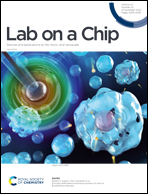3D printing-enabled uniform temperature distributions in microfluidic devices†
Abstract
Many microfluidic processes rely heavily on precise temperature control. Though internally-contained heaters have been developed using traditional fabrication methods, they are limited in their ability to isothermally heat a precisely defined volume. Advances in 3D printing have led to high resolution printers capable of using bio-compatible materials and achieving geometry resolutions near 20 μm. 3D printing's ability to create arbitrary 3D structures with an arbitrary 3D orientation as opposed to traditional microfluidic fabrication methods enables new three-dimensional heater geometries to be created. As examples, we demonstrate three new 3D heater geometries: a non-planar serpentine channel, a tapered helical channel, and a diamond channel. These new geometries are shown through finite element simulation to isothermally heat microfluidic channels of cross section 200 μm × 200 μm with a 0.1 °C temperature difference along up to 91% of a 10 mm length, compared to designs from the literature that are only able to have that same temperature distance over several μms. Finally, a set of design rules to create isothermal regions in 3D based on the desired temperature, heater pitch, heater gradient, and radial space around a target volume are detailed.



 Please wait while we load your content...
Please wait while we load your content...